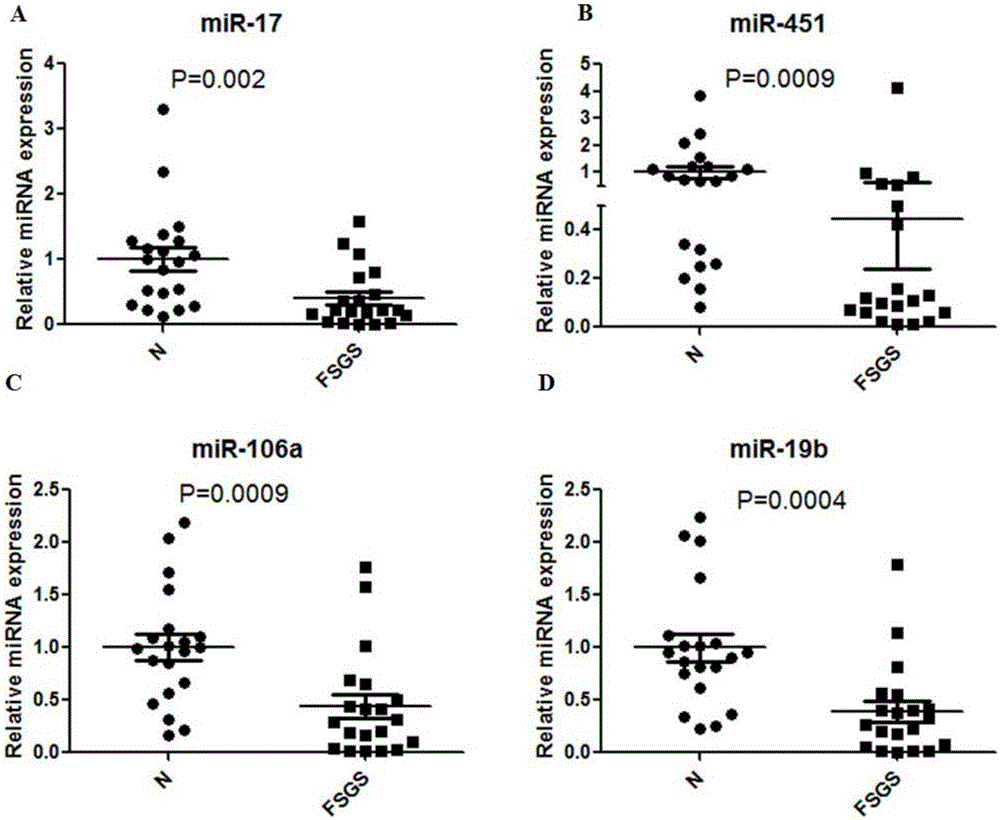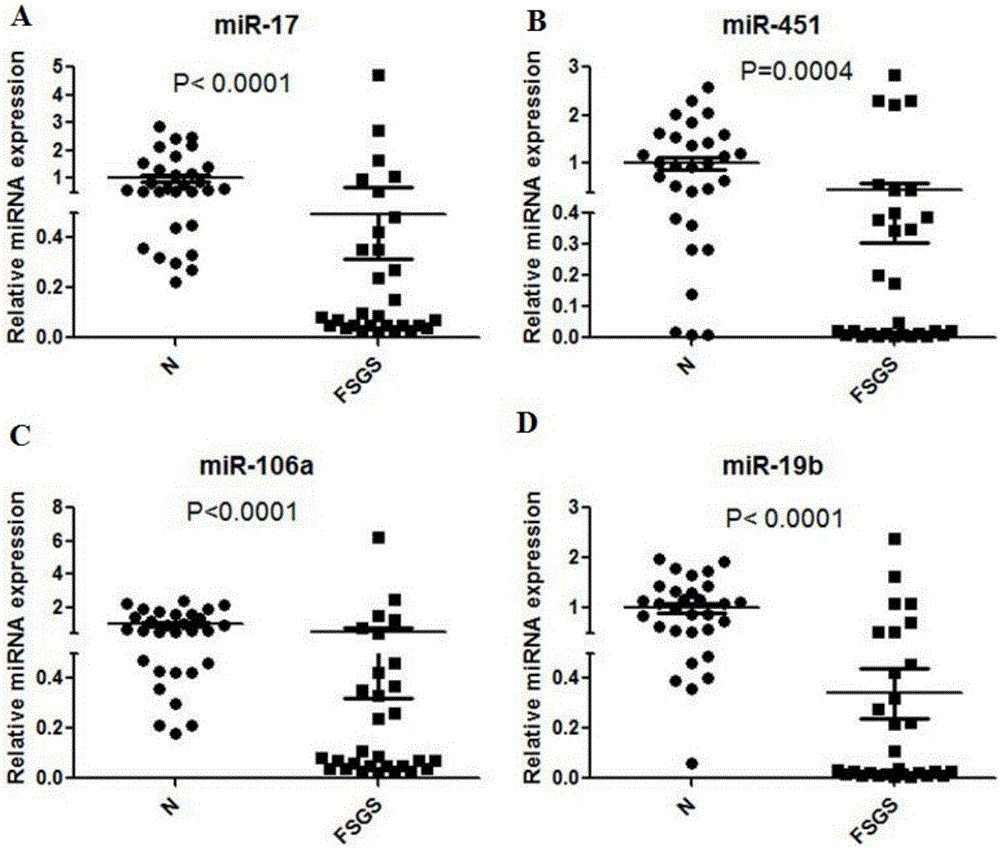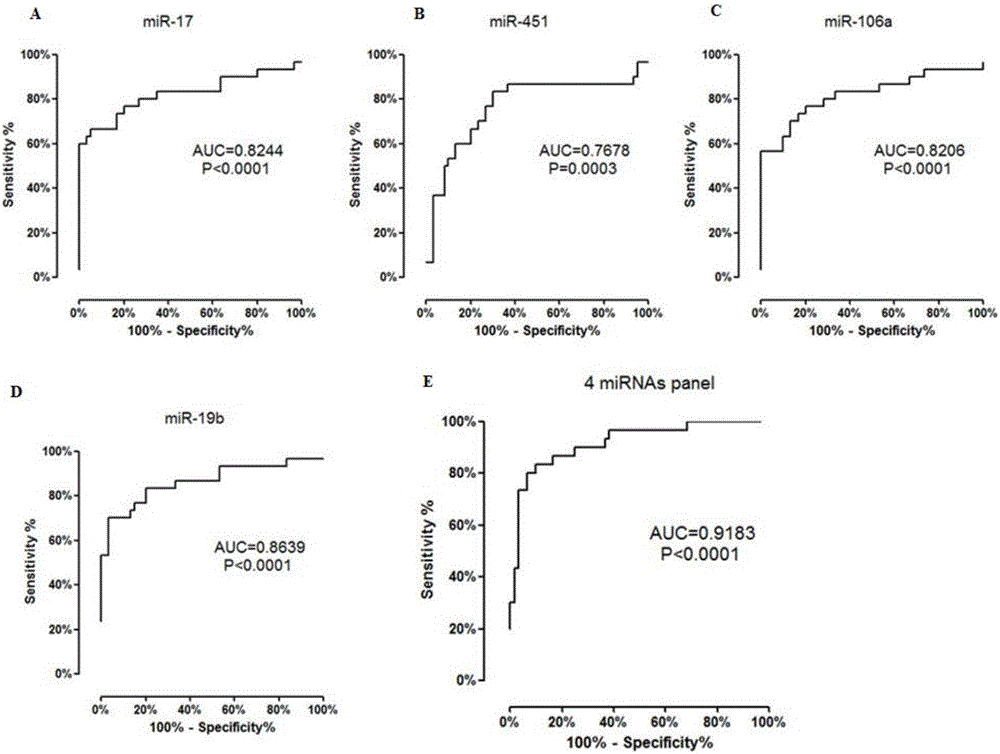Markers for diagnosing and predicating focal segmental glomerulosclerosis
A glomerulosclerosis and focal segmental technology, applied in the field of detection, can solve the problems of lack of blood diagnostic markers, etc., and achieve good market prospects, low detection cost, and high sensitivity
- Summary
- Abstract
- Description
- Claims
- Application Information
AI Technical Summary
Problems solved by technology
Method used
Image
Examples
Embodiment 1
[0018] Embodiment 1, Taqman real-time quantitative PCR detection plasma miRNAs expression profile
[0019] Take the plasma of 20 cases of clinically diagnosed FSGS patients, and take the serum of 20 cases of healthy people as a control, and then extract plasma RNA, the extraction method refers to mirVana TM The PARIS kit is operated, and the specific steps are as follows:
[0020] ①Add an equal volume of 2×DenaturingSolution to 400 μL plasma, vortex for 30 seconds, mix thoroughly, add 10 μL cel-mir-39 (10 nM), and immediately place on ice for 5 minutes;
[0021] ② Add 800 μL of phenol chloroform, vortex for 30-60 seconds;
[0022] ③Centrifuge at 12000×g, 4°C for 15 minutes, separate the supernatant into a clean centrifuge tube;
[0023] ④ Add 1.25 times the volume of the supernatant and 100% ethanol at room temperature to the separated supernatant, and mix well;
[0024] ⑤Pour the mixed liquid into the spin column. If the liquid volume is greater than 700 μL, load it on the...
Embodiment 2
[0033] Example 2, Candidate marker verification for FSGS diagnosis
[0034] In order to verify whether the four candidate markers screened in Example 1 can be used for early diagnosis and prognosis of FSGS, this example expands the sample size. Get 60 routine plasma samples (30 routine FSGS patient plasma and 30 routine healthy person plasma), carry out real-time quantitative PCR according to the method for embodiment 1, the result is as follows figure 2 shown. The results showed that the expressions of miR-17, miR-451, miR-106a and miR-19b in the plasma of FSGS patients were significantly reduced in 60 samples, and it was preliminarily determined that miR-17, miR-451, miR-106a and miR-19b could be used as Markers for early diagnosis and prognosis of FSGS.
[0035] Then the ROC curve was drawn according to the detection results, and the diagnostic sensitivity and specificity of miR-17, miR-451, miR-106a and miR-19b were judged by the area under the curve (AUC) (the closer t...
Embodiment 3
[0036] Example 3, clinical application of plasma miRNAs markers in the diagnosis of FSGS
[0037] In order to evaluate the effect of miR-17, miR-451, miR-106a and miR-19b as markers in the clinical diagnosis of FSGS, 30 plasma specimens of FSGS confirmed by renal tissue biopsy were collected, and 30 healthy human plasma samples were collected as controls , perform quantitative PCR according to the method of Example 1, respectively detect the expression of miR-17, miR-451, miR-106a and miR-19b, and use the 4 miRNAs markers alone or in combination to predict the incidence probability of FSGS. The results show that when miR-17 is detected alone, 23 cases of FSGS can be diagnosed in 30 cases of confirmed FSGS patients, and its sensitivity is 76.7%. Among 30 cases of normal plasma, 24 cases can be diagnosed as normal, and its specificity 80.0%; when miR-451 is detected alone, 25 cases of FSGS can be diagnosed in 30 cases of confirmed FSGS patients, and its sensitivity is 83.3%. In ...
PUM
| Property | Measurement | Unit |
|---|---|---|
| Sensitivity | aaaaa | aaaaa |
| Sensitivity | aaaaa | aaaaa |
| Sensitivity | aaaaa | aaaaa |
Abstract
Description
Claims
Application Information
 Login to View More
Login to View More - R&D
- Intellectual Property
- Life Sciences
- Materials
- Tech Scout
- Unparalleled Data Quality
- Higher Quality Content
- 60% Fewer Hallucinations
Browse by: Latest US Patents, China's latest patents, Technical Efficacy Thesaurus, Application Domain, Technology Topic, Popular Technical Reports.
© 2025 PatSnap. All rights reserved.Legal|Privacy policy|Modern Slavery Act Transparency Statement|Sitemap|About US| Contact US: help@patsnap.com



